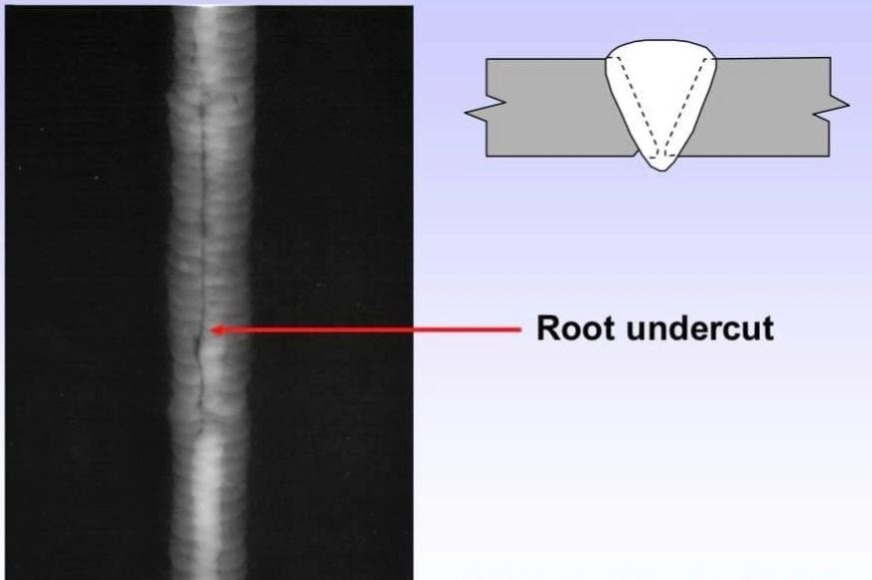Just How to Avoid Weld Undercut: Necessary Tips for Welders
Just How to Avoid Weld Undercut: Necessary Tips for Welders
Blog Article
Recognizing the Causes and Solutions for Undercut Welding in Steel Construction Procedures
In the realm of steel fabrication procedures, the occurrence of undercut welding positions a substantial difficulty that requires an extensive understanding of its causes and sensible remedies. The detailed interplay of numerous factors throughout welding procedures can cause this unfavorable phenomenon, affecting the architectural honesty and total quality of the bonded joints - Preventing weld undercut. By dissecting the origin of undercut welding and discovering effective therapeutic measures, producers can elevate the criterion of their craftsmanship and guarantee the manufacturing of remarkable steel parts
Typical Reasons For Undercut Welding
Regularly overlooked in metal construction, undercut welding occurs due to numerous variables that require precise focus and proficiency to be successfully alleviated. Furthermore, incorrect welding strategies, such as making use of the incorrect welding angle or travel speed, can likewise add to undercut formation. The choice of welding parameters, such as voltage, current, and cable feed speed, plays a considerable role in the event of undercut welding.
Impact of Incorrect Welding Parameters
Inaccurate welding criteria can considerably endanger the integrity and top quality of bonded joints in steel manufacture procedures. The effect of wrong welding parameters shows up in numerous means, bring about architectural weaknesses and defects in the welded parts. One important aspect influenced by incorrect welding parameters is the penetration deepness of the weld. Inadequate warm input because of reduced welding currents or excessively high travel speeds can cause insufficient combination between the base steels, resulting in insufficient joint infiltration and deteriorated bonds. Alternatively, too much heat input triggered by high welding currents or slow-moving travel rates can lead to burn-through and excessive support, creating a weak and unstable weld framework. Furthermore, wrong parameters such as incorrect voltage settings or incorrect electrode angles can add to irregular weld grain profiles, absence of fusion, and raised chances of flaws like undercutting. Thorough interest to welding specifications is paramount to make sure the production of high-grade welds with the desired mechanical properties and structural integrity.
Effect of Improper Torch Angle
Inappropriate lantern angle in welding operations can dramatically impact the top quality and integrity of the final weld joints in metal manufacture processes. The torch angle plays a crucial function in determining the heat input and circulation throughout welding. When the lantern angle is incorrect, concerns such as undercutting can occur. Undercutting is an usual welding flaw where a groove creates along the weld toe, damaging the joint and compromising its architectural stability.
A torch angle that is as well high can result in insufficient penetration, insufficient combination, and enhanced spatter. On the other hand, a torch angle that is also superficial can lead to excessive penetration, burn-through, and distortion of the base material. Preventing weld undercut. Correct lantern angle is important for guaranteeing consistent weld high quality, stamina, and appearance
To protect against undercutting and other defects brought on by improper lantern angles, welders should be educated to maintain the proper lantern angle throughout the welding procedure. Regular tracking and adjustment of lantern angles throughout welding can aid accomplish sound welds with marginal issues.
Role of Inadequate Welding Techniques

Another aspect of inadequate welding techniques is inappropriate weld preparation. Insufficient cleansing of the base steels, wrong joint design, or inadequate side prep work can all add to damage welding. Moreover, poor protecting gas coverage or making use of the incorrect type of gas can result in insufficient fusion and the formation of undercut problems.
To deal with the function of inadequate welding techniques in metal manufacture processes, it is necessary to supply extensive training for welders. Appropriate education and learning on welding parameters, joint prep work, and shielding gas anchor choice can aid stop undercut welding and ensure high-quality welds in steel manufacture jobs.
Reliable Solutions for Undercut Welding
Addressing undercut welding in metal construction calls for carrying out efficient remedies to boost weld high quality and architectural stability. One of the key solutions to battle undercut is to adjust welding parameters such as voltage, present, and take a trip speed to make sure correct warm input check here and blend. By fine-tuning these settings, welders can protect against too much melting of the base metal and filler material, decreasing the chance of undercut formation.
Additionally, appropriate joint preparation is critical in stopping undercut. Making certain clean base metal surface areas cost-free of pollutants and making use of the proper bevel angle can assist advertise far better weld infiltration and lower the danger of undercut - Preventing weld undercut. Employing ideal welding strategies, such as weaving or oscillating the torch, can likewise assist in distributing heat evenly and loading the weld joint appropriately, lessening the possibility of undercut issues
Additionally, choosing the correct welding consumables, including electrodes and filler steels, is crucial in reducing undercut. Utilizing materials with proper chemical structures and mechanical homes can add to achieving audio welds with very little undercut. Regular examination and high quality control actions should likewise be carried out to find and deal with undercut issues promptly, ensuring the overall stability of produced metal parts.

Conclusion
Finally, comprehending the causes and remedies for undercut welding in metal construction processes is crucial for attaining top notch welds. By dealing with usual causes such as incorrect welding criteria, improper torch angle, and insufficient welding methods, welders can stop undercutting and guarantee solid, long lasting welds. It is important to take notice of these variables and execute effective services to improve the total welding process and end product high quality.

Report this page